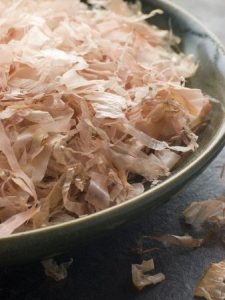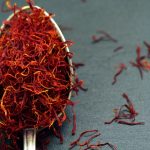Certain fish stocks have been used for centuries to build up flavours and add tastiness to savoury products. The Japanese use katsuo-bushi or katsuobushi which is dried and smoked bonito fish, available as flakes or powder. Bonito (Katsuwonus pelamis) is a tuna caught locally. Bonito flakes are also converted to katsuobushi-dashi which is the main flavour component of dashi , a Japanese broth used in miso soup. The product is also used with boiled vegetables, on cold tofu and to prepare onigri filling and ponzu sauce.

Bonito is a member of the mackeral family and also commonly called skipjack tuna. It was fully appreciated as a flavouring in the 1400s – the Muromachi period, where the samurai had it in their field rations. Dried bonito flakes lend a traditional umami taste to Japanese cooking and have been examined for their use in foods where salt reduction is feasible. The flakes alter salt perception in the same manner as other umami generating ingredients such as monosodium glutamate (MSG) and inosine 5’-monophosphate (IMP) (Yamaguchi and Takahashi, 1984).
Dried bonito is prepared since ancient times using a variety of manufacturing processes. It involves fish filleting with cutting into quarter lengths, then steaming or boiling, sun or repeated smoke drying, trimming and innoculation with moulds to develop the flavour. The fillets are usually air dried outside on special racks for over three months to ferment. Two types of dried bonito are available – arabushi which is a mould-free dried bonito and karebushi, a mould covered variant. The flakes are shaved using a katsuo kezuri-ki (bonito shaver) before use. These drying and innoculation processes generate a series of interesting tastes which are then extracted to produce stock or broth.
The umami sensation is due to IMP (Kohno et al., 2005) and the stock also contains histidine, glutamic acid and other extracted components (Fuke and Konosu, 1991). A new taste modulating component N-lactoylguanosine 5‘-monophosphate (N-lactoyl GMP) was examined using liquid chromatography−electrospray ionization (+) mass spectrometry−mass spectrometry (LC−ESI(+)-MS/MS) with a methanol/ammonium acetate or formate gradient.
The sensory componentry generated also includes a variety of dimethylpyrazines and guaiacol which contribute roasted notes. It is thought that karebushi has a more pungent smoky flavour than arabushi. (Ishiguro et al., 2001).
Bonito flakes are obtained from Mitoku Company Ltd.
References
de Rijke, E., et al., (2007) LC-MS Study To Reduce Ion Suppression and To Identify N-Lactoylguanosine 5′-Monophosphate in Bonito: A New Umami Molecule?J. Agric. Food Chem., 55(16): pp. 6417-6423.
Fuke, S., Konosu, S. (1991) Taste-active components in some foods: a review of Japanese research. Physiol. Behav. 49 pp. 863–8.
Ishiguro, K.,Wakabayashi, H., Kawaguchi, H. (2001) Changes in volatile compounds during smoking process and evaluation of major aroma constituents of dried bonito (katuo-bushi) [Japanese]. Nippon Shokuhin Kogyo Gakkaishi 48 pp. 570–577
Kohno, K., Hayakawa, F., Xichang, W., Shunsheng, C., Yokoyama, M., Kasai, M., Takeutchi, F., Hatae, K. (2005) Comparative study on flavor preference between Japanese and Chinese for dried bonito stock and chicken bouillon. J Food Sci 70 pp 193–198
Yamaguchi, S., Takahashi, C. (1984) Interactions of monosodium glutamate and sodium chloride on saltiness and palatability of a clear soup. J. Food Sci. 49 pp. 82–85


Bonito flakes are great in the cooking I get involved with. Best to use them in a dashi or miso soup if you want great taste in a broth. I also add them to ramen noodles. Absolutely love these. Problem for me is where you get hold of them.